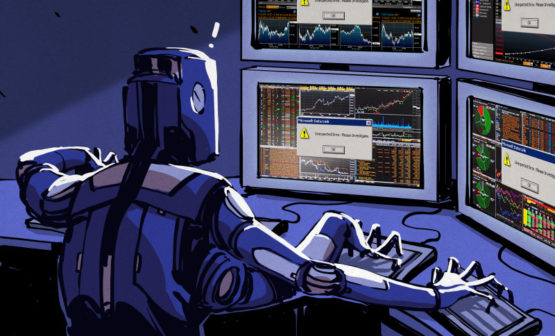Algorithmic Trading Quant Fund: The Industry Going Through a “Quant Winter”
 This article was written by Raphaël Uzan, a financial analyst at I Know First.
This article was written by Raphaël Uzan, a financial analyst at I Know First.
Summary
After being booming, quant investment funds and algorithmic trading have gone through a dark period. In this article, we will introduce what are quant investment funds and which methods they use. Then, we will try to understand the reasons for their performance decrease since 2018.
Quant Investment Funds Use Algorithmic Trading
An investment fund collects money from several investors in order to invest it and to make profit. This capital is managed by professionals in more or less risky ways according to criteria beforehand fixed. There are investment funds based on fundamental analysis and quant investment funds. These latter ones utilize advanced quantitative analysis implementing their strategies through state-of-the-art technology and algorithms. They are generally made up of scientists or computer programmers in addition to the people with financial background. Quantitative analysis is done by processing large quantities of data, essentially historical market data. Over recent years, there are more and more quant funds thanks to the rising data availability. There are around $160bn of assets in these stocks-focused quant mutual funds, according to Nomura.
The quant investment process is divided into three steps: the fund manager sets inputs such as data and rules to follow. Then the algorithms generate estimations for prices, returns and risk parameters. From that, portfolios are built according to mathematical criteria.
Algorithmic Trading Methods
Quant investment funds use different methods to manage the portfolios. With the technological progress over the first 20 years of 21st century, algorithmic trading becomes more and more widespread and quantitative funds are naturally one of the first entities to utilize it.
One of the most known algorithmic trading forms is the high frequency trading, or HFT for short. It represents more than 70% of all U.S. equity volume. The prime advantage of this technology is that computers are able to execute market orders before human traders, due to significantly faster information processing speed, that can reach nanoseconds.There are several uses for the HTF though. It may be sometimes used to manipulate the market using techniques, such as “Spoofing”, “Layering”,“Quote stuffing” or “Smoking”.
There are several points of view on the subject of market disturbance by the algorithmic trading which had impact both on and originating from quantitative funds. We know that it is related to flash crashes such as in May 2010, when the Dow Jones Industrial Average Index which lost about 1000 points before it returned to its original position 15 minutes later. Some research papers were written by the Securities and Exchange Commission (SEC) and the Commodity Futures Trading Commission in order to identify the causes of this event. Some months later, they published a report titled “Findings regarding the market events of May 6, 2010” which was criticized by a lot of financial analysts. There are multiple signs showing that algorithmic trading amplified the phenomenon like market manipulation.
“Quant Winter” is the Consequence
Despite their popularity, most of these funds have recently seen their performance declined. According to Nomura, just 15% of them beat the US stock market last year. Moreover, a lot of quant mutual funds cut jobs or shut offices such as WorldQuant, AQR, Neuberger Berman, Columbia Threadneedle.
We can’t be sure of the reasons but we can state hypotheses. Joseph Mezrich, Head of quantitative strategies at Nomura Instinet qualified the performance “pretty terrible” and called this period a “quant winter”.
The past few years were marked by high volatility in the stock markets. In 2018, all of stock markets in Europe declined. The Euro Stoxx 50 decreased more than 15% and also MSCI EM (emerging markets Index) almost by 18%. Nonetheless, 2018 was considered as global growth year with 3,8%. An analyst from Fidelity International said “The current instability offers new twists every week, especially in Europe, a real concentrate of this permanent turmoil”.
Stock markets experienced disturbances in 2018 due to a lot of geopolitical unrest. There was a new government formation in Italy, elections in Brazil and Mexico, midterms in USA. This global economic slowdown was also caused by Brexit, problems in the Middle East and several economic tensions in general. All of these caused the decline in bond yields. According to Mr Mezrich, “tumbling bond yields” is the reason of this “quant winter”. He also noted that “It’s mainly because macro is not part of their risk management repertoire”.
In 2019, despite Chinese and American tensions, Euro Stoxx 50 index rose up to 26% and Nasdaq index achieved a performance of 36%. Analysts from Lyxor Asset Management said “a paradoxical year where, despite fears of recession and political risks, the markets recorded outstanding performances”.
Conclusion
The algorithms used by quant investment funds process a multitude of data. The market consequences numerical-wise assigned to this data may not be exact. That is to say, computers don’t correctly distinguish one important data from another. As we saw in this analysis, the algorithms didn’t adapt to stock market fluctuations caused by geopolitical and economic unrest.
Thus, we can say that computers haven’t developed yet exact “market awareness” contrary to humans. Indeed, humans can observe a macroeconomic factor which could impact on the market while the algorithms may not always account for it directly. Thereby, this “Quant winter” has proven empirically the limits of this industry. To date, AI isn’t ready to replace traders but it’s an extension enabling them to process data and execute orders with a large quantity and high speed.















